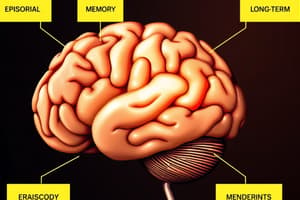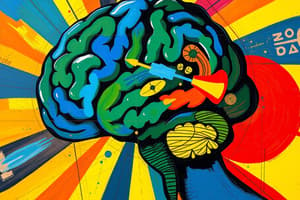Podcast
Questions and Answers
Which of the following is NOT explicitly listed as a type of long-term memory?
Which of the following is NOT explicitly listed as a type of long-term memory?
- Semantic
- Procedural
- Working (correct)
- Episodic
What does 'consolidation' refer to in the context of long-term memory?
What does 'consolidation' refer to in the context of long-term memory?
- The temporary maintenance of information
- The initial encoding of sensory information
- The continued organization and stabilization of memory traces over time (correct)
- The process of retrieving stored information
Which process involves accessing and utilizing stored information from memory traces?
Which process involves accessing and utilizing stored information from memory traces?
- Encoding
- Storage
- Consolidation
- Retrieval (correct)
What is the primary difference between declarative and nondeclarative memory?
What is the primary difference between declarative and nondeclarative memory?
Which of the following is an example of non-associative learning?
Which of the following is an example of non-associative learning?
In the context of memory, what does 'double dissociation' refer to?
In the context of memory, what does 'double dissociation' refer to?
According to the information, what is the neural basis of long-term memory?
According to the information, what is the neural basis of long-term memory?
Which brain area is associated with the encoding of specific personal experiences (episodic memory)?
Which brain area is associated with the encoding of specific personal experiences (episodic memory)?
If a patient shows impairment in a short-term memory task but performs normally on a long-term memory task, this is an example of:
If a patient shows impairment in a short-term memory task but performs normally on a long-term memory task, this is an example of:
In classical conditioning, what happens after the repeated pairing of a neutral stimulus (NS) and an unconditioned stimulus (US)?
In classical conditioning, what happens after the repeated pairing of a neutral stimulus (NS) and an unconditioned stimulus (US)?
What is the key characteristic of non-associative learning?
What is the key characteristic of non-associative learning?
Sensitization, as a form of non-associative learning, involves what type of response?
Sensitization, as a form of non-associative learning, involves what type of response?
Which of the following suggests that short-term and long-term memory are separate systems?
Which of the following suggests that short-term and long-term memory are separate systems?
What is the primary finding regarding the neural basis of habituation in Aplysia?
What is the primary finding regarding the neural basis of habituation in Aplysia?
What is the role of the cerebellum in motor skill learning, specifically motor adaptation?
What is the role of the cerebellum in motor skill learning, specifically motor adaptation?
In the serial reaction time (SRT) task, what does improved performance on a repeating sequence indicate?
In the serial reaction time (SRT) task, what does improved performance on a repeating sequence indicate?
What is the role of prediction error in motor sequence learning that depends on the basal ganglia?
What is the role of prediction error in motor sequence learning that depends on the basal ganglia?
According to the presented material, which of the following is a PRIMARY function of the hippocampus?
According to the presented material, which of the following is a PRIMARY function of the hippocampus?
If a person's arm hurts more the longer he rubs it, which type of non-associative learning is most likely responsible?
If a person's arm hurts more the longer he rubs it, which type of non-associative learning is most likely responsible?
What explains why a single dissociation does not necessarily demonstrate separable memory systems?
What explains why a single dissociation does not necessarily demonstrate separable memory systems?
Which of the following is the MOST ACCURATE representation of how information flows in the reinforcement learning loops?
Which of the following is the MOST ACCURATE representation of how information flows in the reinforcement learning loops?
Why is the study by Eric Kandel on Aplysia so important to the study of non-associative learning?
Why is the study by Eric Kandel on Aplysia so important to the study of non-associative learning?
Which statement accurately relates sensitization to pre-synaptic facilitation?
Which statement accurately relates sensitization to pre-synaptic facilitation?
Patient H.M. had damage to his bilateral medial temporal lobes, patient K.F. had damage to his left temporoparietal cortex, and finally patient M.S. had damage to her right occipital lobe. If these patients showed impairment in a short-term memory task but performed normally on a long-term memory task, how would we label these?
Patient H.M. had damage to his bilateral medial temporal lobes, patient K.F. had damage to his left temporoparietal cortex, and finally patient M.S. had damage to her right occipital lobe. If these patients showed impairment in a short-term memory task but performed normally on a long-term memory task, how would we label these?
Which statement about Patient M.S. is most accurate?
Which statement about Patient M.S. is most accurate?
Flashcards
What is memory?
What is memory?
Acquiring information from experience, maintaining it, and using it to guide behavior and plan future actions.
Encoding
Encoding
Initial creation of memory traces in the brain from incoming information.
Consolidation
Consolidation
Continued organization and stabilization of memory traces over time.
Storage
Storage
Signup and view all the flashcards
Retrieval
Retrieval
Signup and view all the flashcards
Reconsolidation
Reconsolidation
Signup and view all the flashcards
Semantic memory
Semantic memory
Signup and view all the flashcards
Episodic memory
Episodic memory
Signup and view all the flashcards
Procedural memory
Procedural memory
Signup and view all the flashcards
Single Dissociation
Single Dissociation
Signup and view all the flashcards
Double Dissociation
Double Dissociation
Signup and view all the flashcards
Reinforcement Learning
Reinforcement Learning
Signup and view all the flashcards
Implicit memory
Implicit memory
Signup and view all the flashcards
Explicit memory
Explicit memory
Signup and view all the flashcards
Encoding
Encoding
Signup and view all the flashcards
Consolidation
Consolidation
Signup and view all the flashcards
Storage
Storage
Signup and view all the flashcards
Retrieval
Retrieval
Signup and view all the flashcards
Non-associative memory
Non-associative memory
Signup and view all the flashcards
Habituation
Habituation
Signup and view all the flashcards
Sensitization
Sensitization
Signup and view all the flashcards
Conditioning
Conditioning
Signup and view all the flashcards
Skill learning
Skill learning
Signup and view all the flashcards
Motor adaptation
Motor adaptation
Signup and view all the flashcards
Motor Sequence Learning
Motor Sequence Learning
Signup and view all the flashcards
Study Notes
- Assigned chapter 9 reading and lab 6 due March 21 cover long-term memory.
- Memory involves processes, types, systems, and tasks.
- Lesions and double dissociation are methods used in memory study.
- Memory includes short-term and long-term forms.
- Memory can be implicit or explicit.
Implicit Memory
- A type of long-term memory
- Includes non-associative, conditioning, skill learning, and priming.
Explicit Memory
- A type of long-term memory
- Consists of semantic, episodic, consolidation, and reconsolidation aspects.
- Remembering breakfast illustrates different memory components, such as taste, what was eaten, breakfast habits, types of food, the definition of breakfast, how to eat it, and unrelated details.
- Problem:
- Acquiring information, maintaining it, and using it to guide behavior and plans.
- Importance:
- Progress depends on retaining information.
- Those unable to remember the past are doomed to repeat it, according to George Santayana.
- Challenge:
- Determining what to remember and how to retrieve it.
- Learning is approximately equal to memory.
- Memory involves encoding, storage, and retrieval processes, and has semantic, episodic, and procedural types.
- The hippocampus, cortex, and amygdala are the systems involved.
- Free recall, stem completion, and motor sequence learning are tasks.
- Memory requires physical change in the nervous system and is found to be pervasive throughout.
- Encoding is the initial creation of memory traces from incoming information.
- Consolidation involves the organization and stabilization of memory traces.
- Storage is the retention of memory traces.
- Retrieval is accessing stored information.
- Reconsolidation is the possible reorganization and restabilization of memory traces after retrieval.
Long-Term Memory Types and Systems
- Long-term memory dives into declarative(explicit) and nondeclarative(implicit) forms,
- Sensory, short-term and working memories are also subsets.
- Declarative memory includes episodic memory for events and semantic memory for facts.
- Nondeclarative memory includes procedural memory, perceptual representation, classical conditioning, and non-associative learning.
- Dissociation logic distinguishes between STM and LTM by assessing how performance varies across tasks.
- Single dissociation occurs when one function is impaired while another is spared.
- Single dissociation does not definitively prove separate systems.
- Double Dissociation:
- This occurs with two patterns that are flipped, which could indicate reliance on different brain mechanisms if both systems can be impaired independently.
- Short-term memory task:
- Includes memory span via hearing and immediately recalling three words in order.
- Long-term memory task:
- Includes list learning via hearing and immediately recalling ten words in any order, repeating until all are recalled.
- Patient K.F.:
- Experienced damage to the left temporoparietal cortex.
- Demonstrates single dissociation.
- Danger:
- It is tempting to conclude that short-term and long-term memory are separable systems after single dissociation, however, this may not always be true.
- Partial damage argument:
- posits that there is one system for both STM and LTM
- STM is more vulnerable when the system is damaged.
- Compensation argument:
- Suggests one system exists for both STM and LTM, but the brain compensates for LTM tasks when the system is damaged.
- Patient H.M. had damage to bilateral medial temporal lobes.
Double Dissociation
- Seen across two different bran areas can show opposing single dissociations.
- Double dissociation cannot be explained by task difficulty.
- Short-term and long-term memory are separate systems.
- Short-term memory operates on the scale of seconds with limited capacity.
- The neural basis:
- Sustained activation of neurons.
- Long-term memory spans minutes, hours, days, and years and has a massive capacity.
- The neural basis:
- Number and strength of synapses.
- Implicit memory task:
- Uses perceptual identification in the study phase which involves presentation of 24 words for 2 seconds each.
- In the test phase, identification of flashed old and new words is done very briefly to measure priming effect,
- Explicit memory task:
- Requires word recognition, presenting 24 words for 2 seconds each in the study phase, and testing with a mix of old and new words until a response is achieved.
- Participants respond "yes" or "no" if the words were in the study phase.
- Patient M.S. has damage to the right occipital lobe.
- Shows typical word recognition (explicit memory).
- Does not show priming effect (impairment in implicit memory).
- Amnesia patients with Korsakoff’s syndrome & epilepsy show larger than normal priming effects, but have impaired word recognition.
- Cognitive and brain systems for perceptual identification (implicit memory) differ from those for word recognition (explicit memory).
- Implicit long-term memory is non-declarative and independent of conscious awareness.
- It includes procedural memory, conditioning, non-associative learning, and priming
- It operates on the scale of minutes, hours, days, and years.
- Massive capacity and relies on the number and strength of synapses.
- Explicit long-term memory is declarative and available to conscious awareness.
- Explicit memory:
- Can be semantic or episodic.
- Operates on the scale of minutes, hours, days, and years.
- Massive capacity (e.g. ability to hold20,000 word families in adult vocabulary).
- It's neural basis is number & strength of synapses.
- Non-associative learning:
- Involves changes in response to a stimulus over time, with the stimulus itself remaining constant.
- Habituation:
- A reduced response to a repeated stimulus, like no longer hearing a clock ticking.
- Sensitization:
- Increased response to a repeated stimulus, like rubbing your arm until it hurts.
- Non-associative learning involves sensory-motor reflex pathways.
- First evidence of neural basis of non-associative memory found after studies in sea slug Aplysia.
- Habituation involves pre-synaptic depression, seen via same action potential, reduced neurotransmitter release and smaller EPSP.
- Sensitization involves pre-synaptic facilitation, same action potential, increased neurotransmitter release and larger EPSP.
- "Short-term" changes during Habituation & Sensitization last for minutes.
- Shown change in the amount of neurotransmitter released.
- "Long-term" changes during Habituation & Sensitization last for hours, days, weeks.
- Demonstrated change in the number of synapses.
- Conditioning falls under implicit memory.
- In classical conditioning Pavlov noticed there dog learned to salivate in response to a bell that predicted food
- Classical Conditioning:
- Unconditioned Stimulus (US) = food.
- Unconditional Response (UR) = salivation.
- Neutral Stimulus (NS) = bell (before pairing).
- Conditioned Stimulus (CS) = bell
- Conditioned Response (CR) = salivation.
- An initially US (food) leads to UR (salivation).
- After pairing, the CS (bell) leads to CR (salivation).
Fear Conditioning
- US = shock
- UR = freezing
- CS = tone
- CR = freezing
- CS and US converge in the lateral nucleus of amygdala.
- EPSP to tone increases in lateral nucleus of amygdala after repeated pairing with shock.
- Motor skill learning:
- Motor adaptation and motor sequence learning, involving cerebellar loops and cortico-basal ganglia-thalamocortical loops
- The task for motor adaptation is throwing darts with prism glasses.
- Motor coordination relies on:
- Forward model to predict results of motor commands.
- Differences between actual results and predicted results for online error correction, motor learning, and feedback control.
- Serial reaction time (SRT) task:
- The task involves hitting the appropriate buttons when each light turns on in a certain order.
- R designates random order.
- S designates repeating sequence.
- Repetition causes you to get better as it does not require conscious awareness.
- This process is dependent on basal ganglia thalamo cortical loops.
- Depends on basal ganglia & reinforcement learning by selecting action expected to lead to maximum reward, performing action, and using prediction error to update expectations.
- a Dopamine signal from substantia nigra pars compacta (SNc) represents prediction error.
- A larger response is better than expected, where as a smaller response is worse than expected.
- Unexpected rewards generate dopamine signals from the substantia nigra pars compacta (SNc), which excites the direct pathway (via D1 receptors) and inhibits the indirect pathway (via D2 receptors), modifying behavior based on reward
Studying That Suits You
Use AI to generate personalized quizzes and flashcards to suit your learning preferences.




